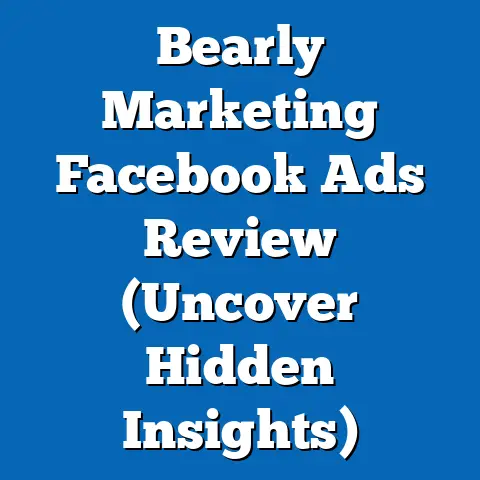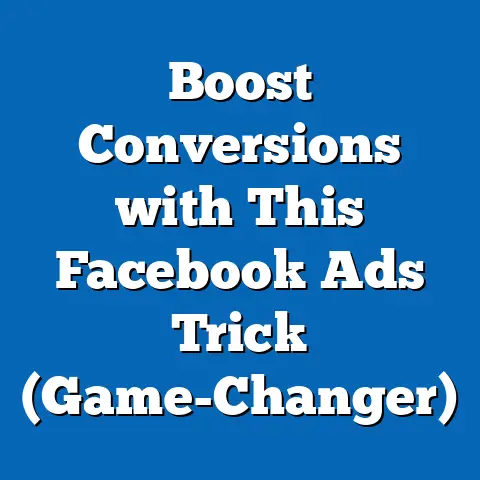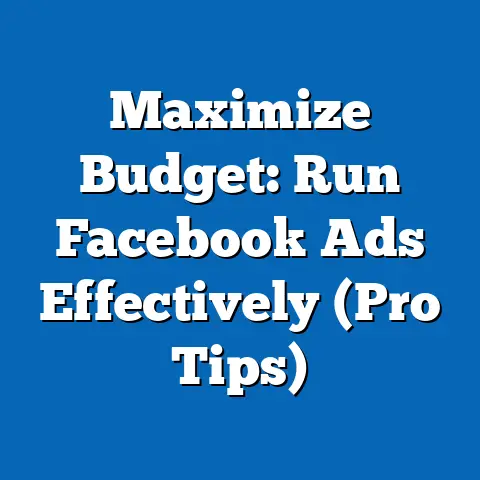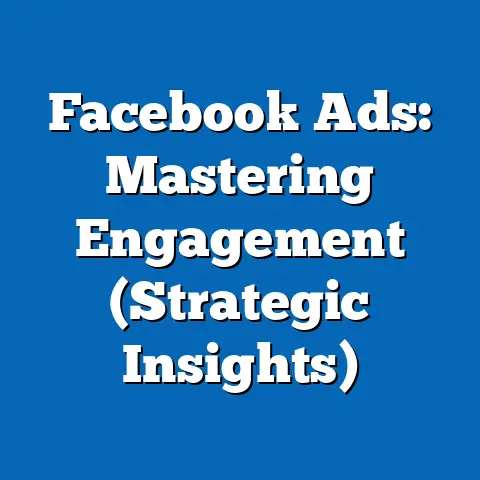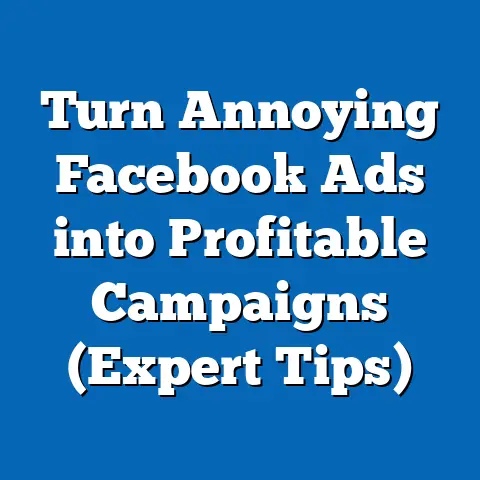Boost Book Sales Through Facebook Ads (Expert Strategies)
Understanding the Facebook Ads Ecosystem
First things first, let’s break down what makes Facebook Ads tick. It’s not just about throwing money at the platform and hoping for the best; it’s about understanding the intricacies of how the system works.
How Facebook Ads Work
Facebook Ads operate on an auction-based system. You, as the advertiser, bid against other advertisers to show your ads to a specific audience. The platform then determines which ads to display based on a combination of factors, including your bid amount, ad quality, and the relevance of your ad to the user.
There are several ad formats available, each with its own strengths:
- Image Ads: Simple and effective, these ads use a single image to convey your message. They’re great for showcasing your book cover or author photo.
- Video Ads: Engaging and dynamic, video ads capture attention and allow you to tell a story. Think book trailers, author interviews, or even just a short clip of someone reading your book.
- Carousel Ads: These ads display multiple images or videos in a scrollable format. Perfect for highlighting different aspects of your book or showcasing a series.
- Collection Ads: Designed for mobile, these ads feature a hero image or video followed by several product images. Ideal for showcasing your book alongside other related products or merchandise.
- Instant Experience Ads: These full-screen, mobile-optimized ads load quickly and provide an immersive experience. Use them to create a virtual book tour or a behind-the-scenes look at your writing process.
The Significance of Targeting and Segmentation
One of the most powerful features of Facebook Ads is its advanced targeting capabilities. You can define your ideal reader based on a wide range of criteria:
- Demographics: Age, gender, location, education, job title, and more.
- Interests: Hobbies, favorite authors, genres, and other topics they’ve shown interest in on Facebook.
- Behaviors: Purchase history, online activity, and other behaviors that indicate their likelihood to buy your book.
- Custom Audiences: Upload your email list or website visitor data to target people who already know you.
- Lookalike Audiences: Create a new audience that shares similar characteristics to your existing customers or fans.
For example, if you’ve written a historical fiction novel set in Victorian England, you could target people who are interested in historical fiction, British history, and authors like Charles Dickens or Jane Austen. You could also target people who have purchased historical fiction books on Amazon in the past. The possibilities are endless.
I remember working with a fantasy author who was struggling to reach her target audience. We used Facebook’s detailed targeting options to narrow down her audience to people who were interested in specific fantasy authors, gaming conventions, and role-playing games. The results were incredible – her ad engagement skyrocketed, and she saw a significant increase in book sales.
Facebook Usage Among Readers and Book Buyers
Here’s a statistic that might surprise you: Over 2 billion people use Facebook every day. That’s a massive audience, and a significant portion of them are readers and book buyers. According to recent studies, book buyers are highly active on social media, with Facebook being one of their preferred platforms.
This means that Facebook Ads offer an unparalleled opportunity to reach your target audience, no matter how niche your genre or subject matter.
Key Takeaway: Understanding the Facebook Ads ecosystem is crucial for success. Take the time to explore the different ad formats and targeting options available to you.
Setting Clear Goals for Your Facebook Ad Campaign
Before you start creating ads, it’s essential to define what you want to achieve. What are your goals for your Facebook ad campaign? Are you trying to increase brand awareness, generate leads, or drive direct sales?
The Importance of Measurable and Realistic Goals
Setting clear, measurable, and realistic goals is crucial for several reasons:
- It provides direction: Goals give you a clear sense of what you’re trying to achieve, which helps you focus your efforts and resources.
- It allows you to track progress: Measurable goals allow you to track your progress and see how well your campaign is performing.
- It enables optimization: By tracking your progress, you can identify areas where your campaign is underperforming and make adjustments to improve your results.
- It helps you justify your investment: Clear goals make it easier to justify your investment in Facebook Ads and demonstrate the value of your marketing efforts.
Types of Goals for Book Marketing
There are several types of goals that are relevant to book marketing:
- Brand Awareness: Increase awareness of your book and author brand. This can be measured by metrics like reach, impressions, and engagement.
- Lead Generation: Collect email addresses from potential readers. This can be measured by metrics like cost per lead and conversion rate.
- Direct Sales: Drive sales of your book on platforms like Amazon or your personal website. This can be measured by metrics like cost per acquisition and return on ad spend (ROAS).
- Website Traffic: Increase traffic to your book landing page or author website. This can be measured by metrics like click-through rate and cost per click.
- Engagement: Encourage people to like, comment, and share your ads. This can be measured by metrics like engagement rate and social shares.
Examples of Goals Specific to Authors
Here are some examples of goals that are specific to authors:
- Increase email subscribers by 20% in the next month.
- Drive 500 clicks to your book landing page in the next week.
- Boost sales on Amazon by 15% in the next quarter.
- Generate 100 pre-orders for your upcoming book.
- Increase attendance at your book signing event by 50%.
When setting your goals, make sure they are SMART:
- Specific: Clearly define what you want to achieve.
- Measurable: Use metrics to track your progress.
- Achievable: Set realistic goals that you can actually achieve.
- Relevant: Ensure your goals align with your overall marketing strategy.
- Time-bound: Set a deadline for achieving your goals.
I once worked with a debut author who had incredibly high expectations for her Facebook ad campaign. She wanted to sell thousands of books in the first month, which was unrealistic given her limited budget and lack of brand awareness. We worked together to set more realistic goals, focusing on building her email list and driving traffic to her website. By setting achievable goals, we were able to build momentum and gradually increase her book sales over time.
Key Takeaway: Setting clear, measurable, and realistic goals is essential for the success of your Facebook ad campaign. Make sure your goals are SMART and align with your overall marketing strategy.
Crafting Compelling Ad Content
Now that you’ve set your goals, it’s time to create some ads. But not just any ads – you need to create ads that are compelling, engaging, and relevant to your target audience.
Engaging Ad Copy
Your ad copy is your opportunity to connect with potential readers and convince them to take action. Here are some tips for writing effective ad copy:
- Know your audience: Understand their needs, interests, and pain points.
- Highlight the benefits: Focus on what readers will gain from reading your book.
- Use strong verbs: Create a sense of urgency and excitement.
- Keep it concise: Get to the point quickly and avoid jargon.
- Tell a story: Use storytelling to capture attention and create an emotional connection.
For fiction writers, storytelling is especially important. Use your ad copy to paint a vivid picture of your book’s world and characters. Entice readers with a compelling hook or a tantalizing glimpse into the plot.
For non-fiction writers, focus on the value you provide. Highlight the problems your book solves and the benefits readers will gain from reading it. Use testimonials or social proof to build credibility.
Visually Appealing Graphics and Videos
In today’s visually driven world, your ad graphics and videos are just as important as your ad copy. Here are some tips for creating visually appealing ads:
- Use high-quality images: Avoid blurry or pixelated images.
- Choose relevant visuals: Use images that relate to your book and target audience.
- Use bright colors: Capture attention and stand out from the crowd.
- Keep it simple: Avoid clutter and focus on a single message.
- Use video: Video ads are more engaging than static images.
Your book cover is a great starting point for your ad visuals. Use it as the main image in your ad or create a short video showcasing the cover. You can also use author photos, illustrations, or even short clips of people reading your book.
I’ve found that video ads perform particularly well for authors. Book trailers, author interviews, and even just short clips of someone reading your book can capture attention and create an emotional connection with potential readers.
Strong Calls-to-Action (CTAs)
Your call-to-action (CTA) is the final push that encourages readers to take action. Here are some tips for creating strong CTAs:
- Use action-oriented language: Tell people what you want them to do.
- Create a sense of urgency: Encourage people to act now.
- Make it clear and concise: Avoid ambiguity and get straight to the point.
- Use contrasting colors: Make your CTA button stand out.
- Test different CTAs: See which ones perform best.
Some effective CTAs for book marketing include:
- Buy Now
- Learn More
- Download a Sample
- Join My Email List
- Visit My Website
I once worked with an author who was struggling to generate leads from her Facebook ads. We analyzed her ads and realized that her CTAs were weak and unclear. We replaced them with more action-oriented CTAs like “Download a Free Chapter” and “Join My Reader Group.” The results were dramatic – her lead generation rate increased by over 50%.
Key Takeaway: Crafting compelling ad content is essential for capturing attention and driving conversions. Focus on creating engaging ad copy, visually appealing graphics and videos, and strong calls-to-action.
Setting Up Your Facebook Ad Campaign
Now that you’ve created your ad content, it’s time to set up your Facebook ad campaign. This involves creating an ad account, selecting your campaign objective, defining your target audience, setting your budget, and choosing your ad placements.
Creating a Facebook Ads Account
If you don’t already have a Facebook Ads account, you’ll need to create one. Here’s how:
- Go to Facebook Ads Manager.
- Click “Create Ad.”
- Follow the prompts to set up your account.
You’ll need to provide your business information, payment information, and other details. Once your account is set up, you’re ready to start creating campaigns.
Selecting the Right Campaign Objective
Your campaign objective is the goal you want to achieve with your ad campaign. Facebook offers several campaign objectives, each designed to optimize for a specific outcome. Here are some of the most relevant objectives for book marketing:
- Awareness: Show your ad to as many people as possible.
- Traffic: Drive traffic to your website or landing page.
- Engagement: Encourage people to like, comment, and share your ad.
- Leads: Collect email addresses from potential readers.
- Sales: Drive sales of your book on platforms like Amazon or your personal website.
Choose the objective that aligns with your goals. If you’re trying to increase brand awareness, choose the Awareness objective. If you’re trying to drive sales, choose the Sales objective.
Budget Setting and Optimization
Setting your budget is a crucial part of setting up your Facebook ad campaign. You need to determine how much you’re willing to spend on your ads and how you want to allocate your budget.
Facebook offers two budget options:
- Daily Budget: Set a daily amount that you’re willing to spend on your ads.
- Lifetime Budget: Set a total amount that you’re willing to spend on your ads over a specific period of time.
When setting your budget, consider your goals, target audience, and the cost of reaching them. Start with a small budget and gradually increase it as you see results.
Optimizing your ad spend is essential for maximizing your return on investment (ROI). Here are some tips for optimizing your ad spend:
- Target the right audience: Make sure you’re targeting people who are most likely to be interested in your book.
- Use relevant ad creatives: Create ads that resonate with your target audience.
- Test different ad placements: See which placements perform best.
- Monitor your results: Track your key performance indicators (KPIs) and make adjustments as needed.
- Pause underperforming ads: Don’t waste money on ads that aren’t working.
A/B Testing Ad Creatives and Targeting Options
A/B testing, also known as split testing, is the process of testing different versions of your ads to see which ones perform best. This involves creating multiple versions of your ads with different headlines, images, CTAs, and targeting options.
By A/B testing, you can identify the most effective combinations of ad creatives and targeting options, which can significantly improve your campaign performance.
Here are some things you can A/B test:
- Headlines: Test different headlines to see which ones capture attention and drive clicks.
- Images: Test different images to see which ones resonate with your target audience.
- CTAs: Test different CTAs to see which ones encourage people to take action.
- Targeting options: Test different targeting options to see which ones reach the most relevant audience.
I always recommend A/B testing different ad creatives and targeting options. It’s the best way to identify what works and what doesn’t.
Key Takeaway: Setting up your Facebook ad campaign involves creating an ad account, selecting your campaign objective, defining your target audience, setting your budget, and choosing your ad placements. Don’t forget to A/B test different ad creatives and targeting options to find the most effective combinations.
Retargeting Strategies for Increased Sales
Retargeting is a powerful strategy for increasing book sales. It involves showing ads to people who have previously interacted with your content or website.
What is Retargeting?
Retargeting is a form of online advertising that allows you to show ads to people who have already visited your website, watched your videos, or engaged with your content on social media. The idea is that these people are already familiar with your brand and are more likely to be interested in your book.
Implementing Retargeting Campaigns
To implement retargeting campaigns, you need to install a Facebook Pixel on your website. The Facebook Pixel is a small piece of code that tracks visitors to your website and their actions.
Once you’ve installed the Facebook Pixel, you can create custom audiences based on website visitors, page views, time spent on your website, and other criteria. You can then show ads to these custom audiences, encouraging them to buy your book or take other actions.
Examples of Effective Retargeting Ads
Here are some examples of retargeting ads that have proven effective in the book industry:
- Show ads to people who visited your book landing page but didn’t buy the book. Offer them a discount or a free chapter to encourage them to complete the purchase.
- Show ads to people who watched your book trailer on YouTube. Remind them of the book’s plot and encourage them to pre-order it.
- Show ads to people who joined your email list. Promote your latest book or offer them exclusive content.
- Show ads to people who liked your Facebook page. Thank them for their support and encourage them to buy your book.
I’ve seen retargeting campaigns work wonders for authors. By showing ads to people who have already expressed interest in their work, they can significantly increase their conversion rates and book sales.
Key Takeaway: Retargeting is a powerful strategy for increasing book sales. Implement retargeting campaigns for users who have previously engaged with your content or website.
Leveraging Facebook Groups and Communities
Facebook Groups and Communities offer a great opportunity for authors to connect with potential readers and build relationships.
Benefits of Engaging with Facebook Groups
Here are some of the benefits of engaging with Facebook Groups:
- Reach a targeted audience: Join groups that are related to your genre or niche.
- Build relationships: Connect with potential readers and fellow authors.
- Share your content: Share excerpts from your book, blog posts, and other content.
- Promote your book: Promote your book in a non-spammy way.
- Get feedback: Get feedback on your writing from other members of the group.
Strategies for Sharing Content and Ads
When sharing content and ads in Facebook Groups, it’s important to add value to the community rather than being overly promotional. Here are some strategies for sharing content and ads in a way that adds value:
- Share helpful tips and advice: Share your expertise and help other members of the group.
- Ask questions: Engage in conversations and learn from other members of the group.
- Participate in discussions: Share your thoughts and opinions on relevant topics.
- Offer free content: Offer a free chapter of your book or a discount code.
- Be authentic: Be yourself and let your personality shine through.
I always advise authors to focus on building relationships rather than just promoting their book. The more you engage with the community, the more likely people are to be interested in your work.
Potential for Organic Reach
Facebook Groups offer a great opportunity for organic reach. When you share content in a group, it’s more likely to be seen by other members of the group than if you share it on your personal profile.
By engaging with Facebook Groups and Communities, you can reach a targeted audience, build relationships, and increase your organic reach.
Key Takeaway: Engaging with Facebook Groups and Communities can help you connect with potential readers and build relationships. Focus on adding value to the community rather than being overly promotional.
Analyzing and Optimizing Your Campaigns
Analyzing and optimizing your campaigns is essential for maximizing your return on investment (ROI).
Using Facebook Ads Manager
Facebook Ads Manager is a powerful tool that allows you to analyze your campaign performance. It provides a wealth of data on your ads, including reach, impressions, clicks, conversions, and cost per acquisition.
Use Facebook Ads Manager to track your key performance indicators (KPIs) and identify areas where your campaign is underperforming.
Key Performance Indicators (KPIs)
Here are some key performance indicators (KPIs) that are relevant to book sales:
- Reach: The number of people who saw your ad.
- Impressions: The number of times your ad was displayed.
- Click-Through Rate (CTR): The percentage of people who clicked on your ad.
- Conversion Rate: The percentage of people who took the desired action (e.g., buying your book).
- Cost Per Acquisition (CPA): The cost of acquiring a new customer.
- Return on Ad Spend (ROAS): The amount of revenue you generated for every dollar you spent on ads.
Track these KPIs to see how well your campaign is performing. If your CTR is low, try testing different headlines or images. If your CPA is high, try targeting a different audience or optimizing your ad spend.
Strategies for Optimizing Ongoing Campaigns
Here are some strategies for optimizing ongoing campaigns based on data insights:
- Pause underperforming ads: Don’t waste money on ads that aren’t working.
- Adjust your budget: Increase your budget for ads that are performing well and decrease your budget for ads that are underperforming.
- Refine your targeting: Narrow down your target audience to reach the most relevant people.
- Test different ad creatives: Try different headlines, images, and CTAs to see which ones perform best.
- Optimize your landing page: Make sure your landing page is optimized for conversions.
I constantly monitor my Facebook ad campaigns and make adjustments as needed. It’s an ongoing process of testing, learning, and optimizing.
Key Takeaway: Analyzing and optimizing your campaigns is essential for maximizing your return on investment (ROI). Use Facebook Ads Manager to track your key performance indicators (KPIs) and make adjustments as needed.
Case Studies and Success Stories
Let’s take a look at some real-life examples of authors who have successfully used Facebook ads to boost their book sales.
Case Study 1: Historical Fiction Author
A historical fiction author was struggling to reach her target audience. She had written a well-researched and engaging novel, but she wasn’t getting the sales she deserved.
We created a Facebook ad campaign targeting people who were interested in historical fiction, British history, and authors like Charles Dickens and Jane Austen. We used a compelling image of her book cover and wrote ad copy that highlighted the book’s unique setting and characters.
The results were impressive. Her ad engagement skyrocketed, and she saw a significant increase in book sales on Amazon. She also gained a large number of new email subscribers.
Key Takeaways:
- Target the right audience.
- Use a compelling image.
- Write engaging ad copy.
Case Study 2: Self-Help Author
A self-help author wanted to increase awareness of her book and generate leads. We created a Facebook ad campaign targeting people who were interested in self-improvement, personal development, and mindfulness.
We used a video ad featuring the author talking about the book’s key concepts and benefits. We also offered a free chapter of the book in exchange for an email address.
The campaign was a huge success. She generated hundreds of new leads and saw a significant increase in book sales on her website.
Key Takeaways:
- Use video ads.
- Offer free content.
- Generate leads.
Key Takeaways from Case Studies
Here are some key takeaways from these case studies:
- Target the right audience: Make sure you’re targeting people who are most likely to be interested in your book.
- Use relevant ad creatives: Create ads that resonate with your target audience.
- Offer value: Give people a reason to click on your ad and take action.
- Test and optimize: Continuously test different ad creatives and targeting options to see what works best.
These case studies demonstrate the power of Facebook Ads for boosting book sales. By following these strategies, you can achieve similar results.
Key Takeaway: Learn from the success of others. Analyze case studies and apply the key takeaways to your own campaigns.
Conclusion
Facebook Ads can be a powerful tool for boosting book sales. By understanding the Facebook Ads ecosystem, setting clear goals, crafting compelling ad content, setting up your campaign effectively, implementing retargeting strategies, leveraging Facebook Groups and Communities, analyzing and optimizing your campaigns, and learning from case studies, you can achieve significant results.
Don’t be afraid to experiment with different strategies and see what works best for you. The key is to be persistent and keep learning.
I’ve seen firsthand how Facebook Ads can transform an author’s career. It’s not a magic bullet, but with the right strategies and a little bit of effort, you can reach your target audience, build relationships, and boost your book sales.
So, what are you waiting for? Start experimenting with Facebook Ads today and see what you can achieve. Your book sales goals are within reach! Now, go forth and conquer the world of Facebook advertising!


